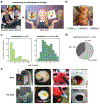Children perceive illusory faces in objects as male more often than female
- PMID: 36791506
- PMCID: PMC10085858
- DOI: 10.1016/j.cognition.2023.105398
Children perceive illusory faces in objects as male more often than female
Abstract
Face pareidolia is the experience of seeing illusory faces in inanimate objects. While children experience face pareidolia, it is unknown whether they perceive gender in illusory faces, as their face evaluation system is still developing in the first decade of life. In a sample of 412 children and adults from 4 to 80 years of age we found that like adults, children perceived many illusory faces in objects to have a gender and had a strong bias to see them as male rather than female, regardless of their own gender identification. These results provide evidence that the male bias for face pareidolia emerges early in life, even before the ability to discriminate gender from facial cues alone is fully developed. Further, the existence of a male bias in children suggests that any social context that elicits the cognitive bias to see faces as male has remained relatively consistent across generations.
Keywords: Childhood development; Face pareidolia; Face perception; Gender; Male bias; Social perception.
Published by Elsevier B.V.
Figures





References
-
- Cassia VM, Turati C & Simion F Can a nonspecific bias toward top-heavy patterns explain newborns’ face preference? Psychol. Sci 15, 379–383 (2004). - PubMed
-
- Johnson MH, Dziurawiec S, Ellis H & Morton J Newborns’ preferential tracking of face-like stimuli and its subsequent decline. Cognition 40, 1–19 (1991). - PubMed
-
- Goren CC, Sarty M & Wu PY Visual following and pattern discrimination of face-like stimuli by newborn infants. Pediatrics 56, 544–549 (1975). - PubMed
-
- Simion F, Valenza E, Umiltà C & Dalla Barba B Preferential orienting to faces in newborns: a temporal-nasal asymmetry. J. Exp. Psychol. Hum. Percept. Perform 24, 1399–1405 (1998). - PubMed
Publication types
MeSH terms
Grants and funding
LinkOut - more resources
Full Text Sources

